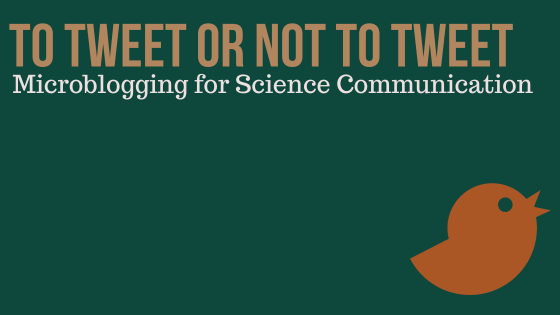Today’s guest blog is written by Kerstin Hurd, a Technical Writer Intern with Promega. Reposted from the Promega Connections blog with permission.
Microblogging is a form of blogging characterized by a shortened format and frequent posting schedule. Instead of personal websites, microblogs reside on social media platforms or apps, making them accessible to interact with and post on smartphones. Microblogs focus on interacting with audiences directly. With the ability to reply to or repost content, microblogging is more conversational and collaborative with audiences than long- form writing.
After its founding in 2006, Twitter (recently renamed “X” by its new owner) quickly became the face of microblogging platforms. Users publish content to the platform in posts of 280 characters that can include images, gifs, videos, and what the platform is most known for: hashtags. Hashtags enable users to search the platform by topic to connect with or follow other users who are writing about those topics. Users can also interact with each other by liking or retweeting tweets, which posts them to their own account. The open forum discussion style makes it possible for individuals to share their stories, offering first-hand accounts of breaking news and fueling political movements such as the Women’s March and Black Lives Matter.
Though Twitter (X) hosts content of all types, it has gained a reputation as a place for scientists to collaborate and discuss with one another in real time. Scientists and academics use it to share research papers and provide feedback, as well as share personal experiences and advice. Over the years, Twitter has served as a platform for scientific findings to reach larger audiences which drove the need for new metrics to measure the impact of scientific research in the context of social media. Recently, Twitter (X) made changes to the platform that threaten the rich discussion and exchange of ideas that made it an appealing platform for science communication, and many scientists are exploring other places to build community.
Creating Your Own Microblog
When creating a microblog for professional purposes, your profile is the place to start. Common practice is to make the profile picture an image of yourself or of something relating to your work. The same goes for the banner. For the biography, consider including information on who you are, what you study, where you work or what your job is. You can also include links to your institute or personal website and “pin” a post to the top of your feed that is representative of your account or personal brand.
To build a following, consistency is key. You will want to share content regularly that is valuable to your followers. In scientific communities, this could include informative articles, thought-provoking questions or anecdotes about your own experiences. Users typically engage more with posts that include images, short videos, or emojis. So, if you want to blog about an academic paper or research, consider posting a single sentence summary of the research and include a key figure as an image. You can also add a hashtag (#) to relevant keywords in your post or include the account names of collaborators or researchers. If you do include hashtags, for readability make sure to capitalize each word of your hashtag like #SciComm or #DataScience.
When used correctly, microblogging can be a great tool to build your professional network and bring attention to your work and interests. To build a strong network and connect with relevant communities, begin by following and interacting with industry leaders and like-minded individuals. You can find people who have similar interests by searching topics with hashtags like #Epigenetics, #Proteomics, or #Biotech. To interact with accounts you can like, repost, or reply. Conferences often also have their own hashtags you can follow to connect with those in attendance and to keep the conversation going online.
The Future of Microblogging
Elon Musk acquired Twitter in October 2022, and since then the platform underwent changes to the verification process, content moderation and even its name. Due to this, many users including those from the science and academic Twitter communities have decided to leave and switch to newer platforms such as Bluesky or Threads.
Bluesky was introduced in 2019 by former Twitter CEO Jack Dorsey as a platform to work parallel to Twitter. Currently, it operates as a separate entity. Many features of the platform are similar to Twitter (X), though Bluesky only allows 256 characters per post. Uniquely, Bluesky provides its current users with limited access codes they can share with friends to invite them to the platform. Since you cannot create an account without an access code, the platform is slow growing.
Threads is a new platform launched in July 2023 from Meta, the company behind Facebook, Instagram and WhatsApp. Though it has a similar posting structure to both Twitter (X) and Bluesky, its 500-character limit is almost double that of other platforms. For Threads, you won’t need an invite to join, but you will need an Instagram account to get your username, password and account name. By connecting to Instagram, which sees 2 billion active users globally, Threads is expected to be a strong competitor with Twitter (X), which sees about 250 million active users.
As it stands, the future of microblogging platforms is uncertain. Twitter (X), Bluesky, Threads and several other platforms are all competing for the same user base. However, regardless of which platform attracts the most users, microblogging has proven to be a valuable tool for sharing timely news, communicating science and having rich discussions with peers from around the world. It remains widely popular and that is unlikely to change.
WOULD YOU LIKE TO SEE MORE ARTICLES LIKE THIS? SUBSCRIBE TO THE ISHI BLOG BELOW!
SUBSCRIBE NOW!


